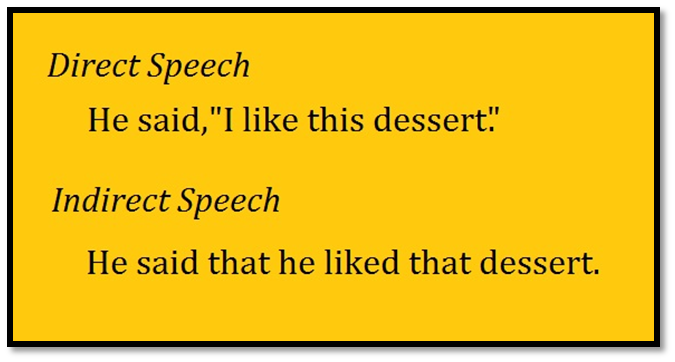Indirect speech –
Indirect speech is a means of expressing the content of statements, questions or other utterances, without quoting them explicitly as is done indirect speech. For example, He said “I’m coming” is direct speech, whereas He said (that) he was coming is indirect speech.
“”Reporting of what a speaker said without quoting his exact words is called ‘Indirect Speech’.””
Rules for changing indirect speech to direct speech
To change from Indirect to Direct Speech, keep in mind all the rules of the Direct Speech in the reverse order.
– Use the reporting verb, “say” or “said to” in its correct tense.
– Remove the conjunctions “that, to, if or whether etc”. wherever necessary.
– Insert quotation marks, question mark, exclamation and full stop, wherever necessary.
– Put a comma before the statement.
– Write the first word of the statement with a capital letter.
– Change the past tense into present tense wherever the reporting verb is in the past tense.
– Convert the past perfect either into past tense or present perfect as found necessary.
– Be careful about the order of words in the question.
– The following column will enable the students to find the kind of sentence.
Download an Android app to learn a simple way of learning the English tense.(There are only three basic tenses in the English language: the past, the present, and the future.)
English Tense
Link – https://play.google.com/store/apps/details?id=com.practise.english_tenses
Indirect (Conjunction) – Direct (Kind of Sentence)
that – Statement (or) Exclamatory sentence
to, not to – Imperative
requested + to – Begin the imperative sentence with “please”
if or whether – Interrogative sentence (Helping Verb + Subject + Main Verb + …?)
What, When, How etc., – (Wh or How + Helping Verb + Subject + Main Verb + …?)

1. Statements:
I told my mother that I wanted coffee then. (I.S.)
I said to my mother, “I want coffee now”. (D.S.)
Yobu told Lazar that he was lying. (I.S.)
Yobu said to Lazar, “You are lying”. (D.S.)
2. Interrogative Sentences:
I asked my sister what she was doing then. (I.S.)
I said my sister, “What are you doing now?”. (D.S.)
The teacher asked the boy why he was late. (I.S.)
The teacher said to the boy, “Why are you late?”. (D.S.)
Johncy asked Rosy if she had done the problem the day before. (I.S.)
Johncy said to Rosy, “Did you do the problem yesterday?”. (D.S.)
3. Imperative Sentences:
She requested me to lend her my Atlas. (I.S.)
She asked to me, “Please lend me your Atlas”. (D.S.)
The conductor told the man to give the old lady his seat. (I.S.)
The conductor said to the man, “Give the old lady your seat”. (D.S.)
4. Exclamatory Sentences:
He exclaimed that it was a very strange idea. (I.S.)
He said, “What a strange idea!”. (D.S.)
She exclaimed that the house was very lovely. (I.S.)
She said, “How lovely the house is!”. (D.S.)
Some famous Question –
1- What is a direct and indirect speech?
Ans – Direct and Indirect Speech. When using indirect or reported speech, the form changes. Usually, indirect speech is introduced by the verb said, as in I said, Bill said, or they said. Using the verb say in this tense, indicates that something was said in the past.
2- What is direct speech and examples?
Ans- Direct speech is a report of the exact words used by a speaker or writer. Contrast with indirect speech. … Direct speech is usually placed inside quotation marks and accompanied by a reporting verb, signal phrase, or quotative frame.
Download an Android app to learn a simple way of learning the English tense.(There are only three basic tenses in the English language: the past, the present, and the future.)
English Tense
Link – https://play.google.com/store/apps/details?id=com.practise.english_tenses
